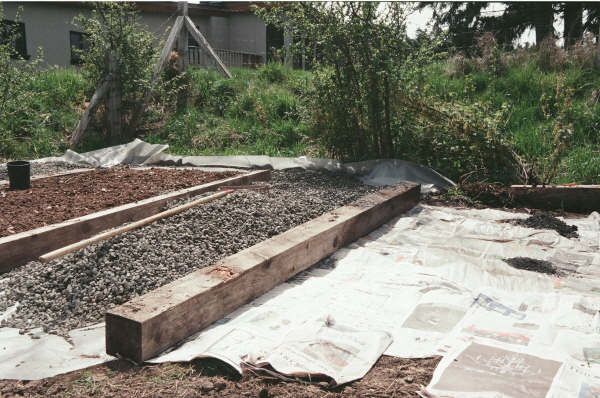There is an organic gardening revolution happening right now. Most of us have concerns about our food security, the use of pesticides on commercially-grown food, and the effects that fruits and vegetables imported from afar is having on global warming.
That is why I decided to join the local food movement last spring by building my very own vegetable garden. As a full-time student with more experience in bookkeeping than vegetable growing, I was keen to find a way of building a garden with a minimum amount of back-breaking digging, and as cheaply as possible. I decided to try the “Lasagna Gardening” method when my Gran gave me a copy of the book, Lasagna Gardening by Patricia Lanza. The book recommends starting a lasagne garden right over an existing lawn or garden, and February to March is the perfect time to start your own.

A layer of wet newspaper is laid down to begin a new lasagna garden.
The first step is to lay down overlapping layers of wet cardboard or wet newspapers to kill the weeds below, and to attract earthworms. I found that the garden I started with newspaper as a base didn’t kill the aggressive bindweed (wild morning glory) below, while the garden with cardboard as a base was relatively weed free all summer.
The second step is to alternate three to four-inch layers of green (nitrogen) and brown (carbon) organic materials, much like building a compost heap. The only thing that shouldn’t go in is meat, fat, or bones. You should continue layering until the garden is about 1.5 to 2 feet high (don’t worry; it will reduce down to a few inches really quickly). I had great success by alternating grass clippings, shredded leaves, and well composted horse manure from my neighbour’s farm. It is also important to put a thin layer of coir or cocoa peat between the different layers of materials, and spraying each layer with water as you go, so that your lasagne garden maintains enough moisture for the microbes and earthworms in the soil to flourish. Coir can be found at Dig This, and is a cheaper, more renewable alternative to peat moss.

Tomatoes grown in Jared’s lasagna garden.
The third and final step is to “cook” the lasagna garden. This involves covering your garden with black plastic which will cook the materials into black earth in six to eight weeks. The book does say that you can plant seedlings right in the lasagna garden the day you build it if you really want to. To maintain the garden you just keep adding layers throughout the year to suppress the weeds, and to feed your luscious, loamy, living soil.
I had fantastic results with my lasagna gardens! I had more tomatoes and zucchini than I could give away, and my little artichoke sets have already expanded into a thriving patch. I also realized that the lasagna garden holds moisture much longer than dirt based gardens, and I really only needed to water it one to two times per week (as opposed to my non-lasagna garden which needed water daily). I found that any weeds that did grow pulled free like butter (roots and all!), and by the end of the summer, the earthworms had tilled my soil far below the cardboard base. Best of all- I didn’t pick up a shovel once!
For more information, visit http://savorynotebook.blogspot.com/2008/04/lasagna-gardening.html
For advice on how to grow specific vegetables, check out http://ourgardengang.tripod.com/lasagna_gardening.htm
ABOUT THE AUTHOR
Jared Witt
Jared Witt is an accounting student at Camosun College in Victoria, BC and the bookkeeper for Dig This, a garden supplies store. Visit www.digthis.com for gardening information and to sign up for their monthly newsletter.
This article is from Canadian Teacher Magazine’s March 2009 issue.












